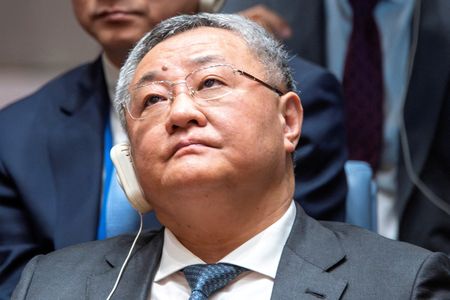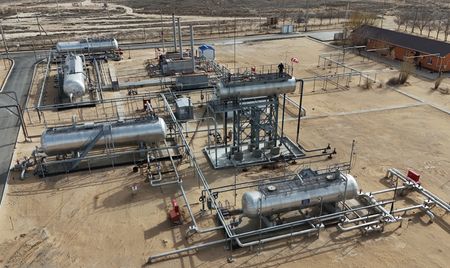By Georgina McCartney
HOUSTON (Reuters) -Oil prices slipped 2% on Wednesday as sources said OPEC+ would consider accelerating its oil output increases in June, but losses were curbed following a report that U.S. President Donald Trump may cut tariffs on Chinese imports.
Brent crude futures settled down $1.32, or 1.96%, at $66.12 a barrel, while U.S. West Texas Intermediate crude ended $1.40, or 2.2%, lower at $62.27.
Global benchmark Brent hit a session high at $68.65, its highest since April 4, before the OPEC+ news.
Several OPEC+ members will suggest that the group accelerate oil output increases for a second consecutive month in June, three sources familiar with OPEC+ talks told Reuters.
There have been recent tensions among OPEC+ members over compliance with production quotas.
“It wouldn’t surprise me that OPEC wants to raise production. It could raise concerns about the cohesion of the cartel. Maybe they’re tired of holding back production increases,” said Phil Flynn, an analyst with Price Futures Group.
Both benchmarks pared some losses in early afternoon trade after Kazakhstan’s Energy Ministry issued a statement saying that Kazakhstan, not an OPEC member but an ally in the OPEC+ group, was a responsible participant in the international energy community and it was interested in predictability and the demand and supply balance.
Kazakhstan has angered other OPEC+ members by producing more than its allotted quota.
“Our participation in OPEC+ is an important tool for ensuring global stability, creating conditions for the implementation of national plans and attracting investment. We are committed to constructive work within the framework of the agreement and fulfilling our obligations,” the statement quoted Energy Minister Erlan Akkenzhenov as saying.
Earlier, Akkenzhenov told Reuters his country will prioritise national interests over those of the OPEC+ producer group when deciding its oil output levels.
The market also saw some support after government data showed that U.S. crude stockpiles rose unexpectedly last week, while both gasoline and distillate inventories fell more than expected.
“We saw another bullish products inventory decline during build season,” said Josh Young, chief investment officer at Bison Interests. “It doesn’t seem to reflect potential demand decline from Trump’s tariff/trade war, yet.”
POTENTIAL FOR TARIFF REPRIEVE
News on tariffs also helped curb some oil price losses. U.S. President Donald Trump’s administration would look at lowering tariffs on imported Chinese goods pending talks with Beijing, a source familiar with the matter said on Wednesday, adding that any action would not be made unilaterally.
The China tariffs are likely to come down to between 50% and 65%, according to a Wall Street Journal report, citing a White House official.
U.S. Treasury Secretary Scott Bessent said he believes that excessively high tariffs between the U.S. and China will have to come down before trade negotiations can proceed.
Trump has backed away from the threat of firing Federal Reserve Chair Jerome Powell after days of criticising the Fed for not cutting interest rates, easing investor fears about economic uncertainty.
The U.S. issued new sanctions targeting an Iranian shipping magnate whose network handles Iranian liquefied petroleum gas and crude oil worth hundreds of millions of dollars.
(Reporting by Georgina McCartney in Houston, Shadia NasrallaAdditional reporting by Robert Harvey in London, Jeslyn Lerh in SingaporeEditing by Louise Heavens, David Goodman, Rod Nickel, Nia Williams and Marguerita Choy)











